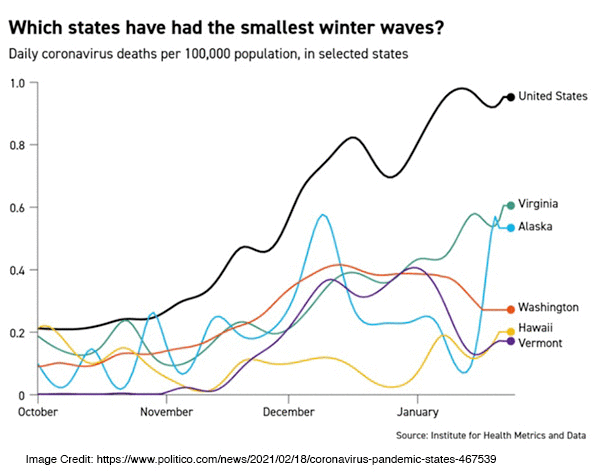Most everyone has grown tired of the pandemic; it has caused great disruption in our lives, and terrible pain and suffering for families who have either lost a loved one, have had to endure serious illness, or whose economic livelihood has been adversely affected. While recent reports from the University of Virginia suggest an uptick of local cases, the good news is that vaccinations are on the rise (a recent report suggests that over 30 percent locally have received at least one shot), and more vaccine is arriving daily. When you have the chance to get a shot, do it!
Why States Matter
Since the onset of the pandemic a year ago, most of the action in combating the pandemic has centered on the states if only because President Trump said early in the crisis that he would “leave it to the Governors.” If you ever wanted an argument to show “why states matter,” this was it. State Governors took the lead by issuing a series of executive orders designed to slow the spread of the virus. Governor Northam has issued many such orders since last March. Last week, he extended Executive Order 72, which retains the 10-person limit on social gatherings and the requirement to wear masks in public places through February 28.

Over the last year, we have witnessed a patchwork of responses throughout the nation. Different states and their governors have emphasized different approaches at different times. And we are seeing the same in their approaches to vaccination.
With the development of the vaccines and a new and engaged President, the federal government has stepped in to provide some level of coordination that was largely lacking with Trump. Nonetheless, the administration of the vaccination process has largely fallen on the states, and they have been beset by a series of challenges from the beginning. The nation’s recent weather has not helped, but there is evidence that production is ramping up. The challenge now is to deliver the supply and have the trained personnel ready to administer the shots.
Reporting on state responses can be found in many places, and today, I recommend three. First, Politico has just initiated a new series to explore the best ideas emerging from the 50 states to deal with the pandemic. Second, William Galston and Elaine Kamark from Brookings just published a piece looking at state metrics for vaccine distribution. Their study ranked Virginia 6th of all the states in vaccine efficiency, defined as the percentage of doses received that have been administered, and 12th in terms of the number of persons who had received at least one shot. This ranking is consistent with the February 19 report by Becker’s Hospital Review, a source considered among the most reliable in the reporting of these data. These statistics can and do vary by the day, so the commonwealth would do well to keep pushing.
Among the best performers were West Virginia and North Dakota, both of which worked with their independent pharmacies to get vaccines into nursing homes. Connecticut ranked second in the Brookings study, and benefited from being one of the first states to create mass vaccination sites.
And finally, The New York Times recently reported that New Mexico had administered two shots to 9.3 percent of its population, 2nd highest of all the states (Virginia lagged behind other states in this metric). Many attribute this high rating to the state’s early creation of a statewide appointment website and its efficiency in transferring unused doses to other facilities at the end of each day.
Vaccination will eventually get the virus under control. In the meantime, another measure of a state’s success can be found in how successful they have been in keeping their death tolls low. Again, Virginia has fared well in this measure. The Politico report argues that “Virginia’s death rate began to significantly outperform most other states starting in October,” and suggests that the commonwealth’s mask requirements has a lot to do with it.
While this is no reason to relax social distancing or other prevention measures, it suggests that the commonwealth may emerge from the pandemic more quickly than some other places.
Getting Vaccinated
While we certainly can learn from other states, many are justifiably focused on getting vaccinated. Here are some ways to do so. Virginia just launched a pre-registration website and call center for sign-up, vaccinate.virginia.gov. You can access it here. Anyone can register, but only people in Phases 1a and 1b (ages 65+ and ages 16-64 with underlying health conditions) are currently being vaccinated. You should receive confirmation that your registration has been received, but if not, you can call the Virginia Department of Health’s hotline at 877-VAX-IN-VA (877-829-4682). If the pandemic has taught us anything, it is patience, and you may have to wait a little time to get through.
Vaccine doses are also being administered through certain pharmacies, including some CVS and Walgreens stores. There have been some challenges getting registered for these, but CVS maintains a site where people over 65 can check as additional appointments become available. As of this writing, all doses at the CVS locations were “fully booked” but hopefully more options will become available as more dosages are delivered.
You can stay on top of the Virginia’s COVID initiatives here. For local information and a COVID dashboard, see info from our Blue Ridge Health Department. The state also maintains a vaccine dashboard that provides data on the number of vaccines distributed to health care providers and the number of doses given, and an interactive map with information about the vaccination phases of different health districts.
We Will Beat This Thing
The way we will beat this thing is by taking precautions, wearing a mask when leaving your residence, maintaining physical distance from others, washing hands frequently, and eventually getting vaccinated. We will also do it by learning from other states. Determining what works has never been more important and watching the efforts in other states will help deliver vaccines faster and save more lives.
More information about the varied responses of the states to the pandemic, especially in its early stages, can be found in my forthcoming book, Fighting Gridlock: How States Shape the Nation and Our Lives (foreword by Senator Mark R. Warner), to be published late summer 2021 by the University of Virginia Press.
